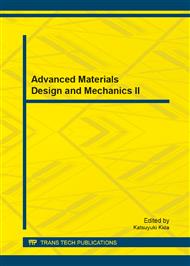[1]
Haijun Yua, b, Yiming Caoa, Guodong Kanga, Jianhui Liua, Meng Li , Quan Yuana Enhancing antifouling property of polysulfone ultrafiltration membrane by grafting zwitterionic copolymer via UV-initiated polymerization. Journal of Membrane Science, 342 (2009).
DOI: 10.1016/j.memsci.2009.05.041
Google Scholar
[2]
Kenneth S. McGuire, Kevin W. Lawson, Pore size distribution determination from liquid permeation through microporous membranes, Journal of Membrane Science, 99 (1995) 127-137.
DOI: 10.1016/0376-7388(94)00209-h
Google Scholar
[3]
Kogutid, K. and K. Kuns, RO and NF membrane fouling and cleaning and pore size distribution variations, Desalination, 150(2002) 13-120.
DOI: 10.1016/s0011-9164(02)00936-0
Google Scholar
[4]
Yan, L., Y. Li, C. Xiang, and S. Xianda, Effect of nano-sized Al2O3-particle addition on PVDF ultrafiltration membrane performance, Journal of Membrane Science, 276(1-2) (2006) 162-167.
DOI: 10.1016/j.memsci.2005.09.044
Google Scholar
[5]
Z. Harun, M. R. Jamalludin, M. Z. Yunos, M. F. Shohur and A. F. Ismail. The Effect of Amorphous Rice Husk Silica to the Polysulfone Membrane Separation Process, Applied Mechanics and Materials, 701 (2013) 319-322.
DOI: 10.4028/www.scientific.net/amr.701.319
Google Scholar
[6]
Z. Harun, M. F. Shohur, M. Z. Yunos, M. R. Jamalludin and A. F. Ismail. The Effect of Crystalline Rice Husk Silica on Polysulfone Membrane for Wastewater Treatment, Applied Mechanics and Materials, 328 (2013) 798–801.
DOI: 10.4028/www.scientific.net/amm.328.798
Google Scholar
[7]
Yunos M. Z., Z. Harun, Basri H., & Ismail A. F. Effects of Water as Non-Solvent Additive on Performance of Polysulfone Ultrafiltration Membrane, Advanced Materials Research, 488-489 (2012) 46–50.
DOI: 10.4028/www.scientific.net/amr.488-489.46
Google Scholar
[8]
Z. Harun, N. F. Ismail, N. A. Badarulzaman , Effect of MgO Additive on Microstructure of Al2O3, Advanced Materials Research, 488 - 489 (2012) 335-339.
DOI: 10.4028/www.scientific.net/amr.488-489.335
Google Scholar
[9]
Jung, B., J.K. Yoon, B. Kim and H.W. Rhee. Effects of molecular weight of polymeric additives on formation, permeation properties and hypochlorite treatment of asymmetric polyacrylonitrile membranes, Journal Member Sci. 243 (2004) 45-47.
DOI: 10.1016/j.memsci.2004.06.011
Google Scholar
[10]
Huang, J., Xue, J., Xiang, K., Zhang, X., Cheng, C., Sun, S., and Zhao, C., Surface modification of polyethersulfone membranes by blending triblock copolymers of methoxyl poly(ethylene glycol)–polyurethane–methoxyl poly(ethylene glycol). Colloids and Surfaces B: Biointerfaces, 88(1) (2011).
DOI: 10.1016/j.colsurfb.2011.07.008
Google Scholar
[11]
Singh, R. Hybrid membrane systems for water purification: technology, systems design and operation: Elsevier, USA, (2006).
Google Scholar
[12]
J. Taurozzi, H. Arul, V. Bosak, A. Burban, T. Voice, M. Bruening, V. Tarabara, Effect of filler incorporation route on the properties of polysulfone–silver nanocomposite membranes of different porosities, Journal of Membrane Science, 325 (2008).
DOI: 10.1016/j.memsci.2008.07.010
Google Scholar
[13]
M. Lind, A. Ghosh, A. Jawor, X. Huang, W. Hou, Y. Yang, E.M.V. Hoek, Influence of zeolite crystal size on zeolite-polyamide thin film nanocomposite membranes, Langmuir, 25 (2009) 10139–10145.
DOI: 10.1021/la900938x
Google Scholar
[14]
Mishra, P., Chakraverty, A. and Banerjee, H.D. Production and Purification of Silicon by Calcium Reduction of Rice-Husk White Ash, Journal Master Science. 20 (1985) 4387-4391.
DOI: 10.1007/bf00559326
Google Scholar
[15]
Z. Harun, N. H. Kamarudin, N. A. Badarulzaman, Shell mould composite with rice husk, Key Engineering Materials, 471-472 (2011) 922-927.
DOI: 10.4028/www.scientific.net/kem.471-472.922
Google Scholar
[16]
Yanlei Su, chao Li, Wei Zhao, Qiang Shi, Haijing Wang, Zhongyi Jiang, Shiping Zhu, Modification of polyethersulfone ultrafiltration membranes with phosphorylcholine copolymer can remarkably improve the antifouling and permeation properties, Journal of Membrane Science 322 (2008).
DOI: 10.1016/j.memsci.2008.05.047
Google Scholar
[17]
C. Bath , M. C Goncalves , A.T.N. Pires , J. Roeder, B. A Wolf., Effects of thermodynamic conditions during formation on their performance, Journal of membrane science. 169 (2000) 287-299.
DOI: 10.1016/s0376-7388(99)00344-0
Google Scholar
[18]
Jian Huang, Kaisong Zhang, Kung Wang, Zongli Xie, Bradley Ladewing, Huanting Wang., Fabrication of polyethersulfone-mesoporous silica nanocomposite ultrafiltration membranes with antifouling properties, Journal of membrane science, 423-424 (2012).
DOI: 10.1016/j.memsci.2012.08.029
Google Scholar



